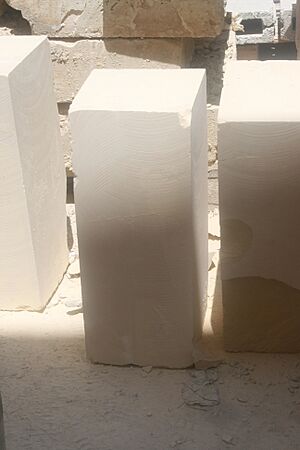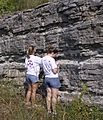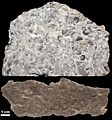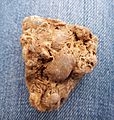Limestone facts for kids
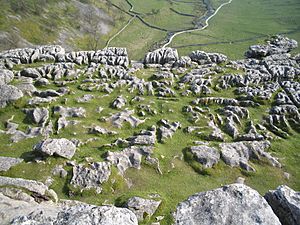
Limestone is a type of sedimentary rock. It is mostly made of a mineral called calcite. Calcite is a form of calcium carbonate, which has the chemical formula CaCO3.
This calcium carbonate is first made by tiny living things. Later, some of it dissolves in seawater. Limestone rocks are mainly formed from the remains of these organisms and from calcium carbonate that settles out of the water.
Limestone makes up about 10% of all sedimentary rocks found on Earth.
Contents
How Limestone Forms
Limestones are mostly made from calcium carbonate. This material is first created by very small living things that use sunlight to make food. These include certain bacteria, tiny algae called coccolithophores, and other types of algae.
Then, larger animals use this carbonate. For example, bivalves (like clams) and polyps (which build coral reefs) use it. They create their shells or skeletons from CaCO3 crystals. Scientists believe that coccolithophores were the first organisms to send a steady "rain" of calcium carbonate from the ocean's surface to the deep sea.
Carbonate rocks are formed from these living sources. They also form when CaCO3 settles out of water. This happens when the water's conditions change. For instance, if there's a lot of CaCO3 in the water, a drop in temperature or a change in pH (how acidic or basic the water is) can cause it to form solid rock.
Florida Bay: A Limestone Factory
Florida Bay is a shallow area of water located behind the Florida Keys. It's a great example of how limestones formed on ancient continental shelfs. Even though the specific animals and plants were different long ago, the overall environment was similar.
In Florida Bay, there is a lot of sea grass. The water is also often milky white because it's full of calcium carbonate. This carbonate is mainly produced by a small red alga called Melobesia, which lives on the sea grass.
Organisms in Florida Bay also produce a lot of slime. This slime is a type of polysaccharide (a complex sugar). Scientists think this slime helps tiny microorganisms control how their carbonate skeletons are formed. It also helps limit how much carbonate dissolves back into the water.
Florida Bay is a flat area that has created a huge amount of carbonate rock over time. If you drill down, you would have to go more than 3,000 feet deep before reaching a different type of rock. That rock would be from the Cretaceous period, about 70 million years ago!
Limestone with Fossils
Many limestones contain fossils, which are the preserved remains of ancient life. Some limestones are almost entirely made up of skeletal material. For example, Chalk is about 99% coccoliths (tiny fossilized algae). Solnhofen Limestone is famous for its well-preserved animal fossils. There are also many limestones from different time periods that are full of shells.
Limestone is not found much before the Cambrian period. This is because animals with hard shells had not yet evolved by then.
From Limestone to Marble
When limestone is heated to a very high temperature and squeezed deep inside the Earth, often at the base of a mountain, it changes. It recrystallizes into a different type of rock called marble. Marble is a metamorphic rock.
Marbles are quite dense and relatively easy to cut or shape into blocks. Some forms of marble are pure white, making them popular for statues and buildings.
What Limestone is Used For
Limestone is strong enough to resist weathering (being worn away by wind and rain). However, it is usually soft enough for stonemasons (people who cut and shape stone) to work with it. Because of this, it is widely used as a building material.
Portland limestone, a specific type of limestone, became very popular in the 19th and 20th centuries. It was used to build many important structures like churches, banks, and houses. However, acid rain can slowly wear away limestone over time.
Limestone is also used to make glass and cement. It plays an important role in making iron in a blast furnace. In this process, limestone helps remove unwanted materials from the iron ore.
Related pages
Images for kids
-
Ooids from a beach on Joulter's Cay, The Bahamas
-
Travertine limestone terraces of Pamukkale, Turkey.
-
El Capitan, an ancient limestone reef
-
Mønsted is the largest limestone mine in the world.
-
Coral reef at Nusa Lembongan, Bali, Indonesia
-
A limestone plate with a negative map of Moosburg in Bavaria is prepared for a lithography print.
-
Limestone quarry at Cedar Creek, Virginia, USA
-
A stratigraphic section of Ordovician limestone exposed in central Tennessee, U.S. The less-resistant and thinner beds are composed of shale. The vertical lines are drill holes for explosives used during road construction.
-
Photo and etched section of a sample of fossiliferous limestone from the Kope Formation (Upper Ordovician) near Cincinnati, Ohio, U.S.
-
A concretionary nodular (septarian) limestone at Jinshitan Coastal National Geopark, Dalian, China
-
Limestone from Lake Tai, used in gongshi, a Chinese stone art
-
Folded limestone layers on Cascade Mountain in Provo Canyon, Utah
-
Fossils in limestone from the northern Black Sea region
See also
 In Spanish: Caliza para niños
In Spanish: Caliza para niños



